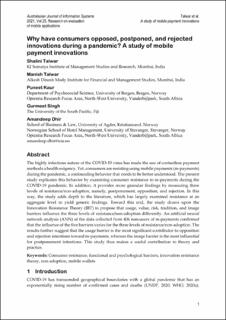Why have consumers opposed, postponed, and rejected innovations during a pandemic? A study of mobile payment innovations
Journal article, Peer reviewed
Published version

Åpne
Permanent lenke
https://hdl.handle.net/11250/2992581Utgivelsesdato
2021Metadata
Vis full innførselSamlinger
Originalversjon
AJIS. Australasian Journal of Information Systems. 2021, 25. 10.3127/AJIS.V25I0.3201Sammendrag
The highly infectious nature of the COVID-19 virus has made the use of contactless payment methods a health exigency. Yet, consumers are resisting using mobile payments (m-payments) during the pandemic, a confounding behavior that needs to be better understood. The present study explicates this behavior by examining consumer resistance to m-payments during the COVID-19 pandemic. In addition, it provides more granular findings by measuring three levels of resistance/non-adoption, namely, postponement, opposition, and rejection. In this way, the study adds depth to the literature, which has largely examined resistance at an aggregate level to yield generic findings. Toward this end, the study draws upon the Innovation Resistance Theory (IRT) to propose that usage, value, risk, tradition, and image barriers influence the three levels of resistance/non-adoption differently. An artificial neural network analysis (ANN) of the data collected from 406 non-users of m-payments confirmed that the influence of the five barriers varies for the three levels of resistance/non-adoption. The results further suggest that the usage barrier is the most significant contributor to opposition and rejection intentions toward m-payments, whereas the image barrier is the most influential for postponement intentions. This study thus makes a useful contribution to theory and practice.
